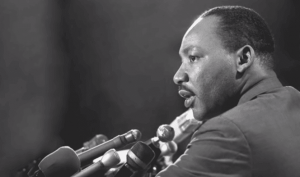Martin Luther King Jr. and His Quest for Civil Rights

Martin Luther King Jr. was an inspiring man who represented the best in human beings. He’s one of the most influential historical figures in the world.
What this Baptist preacher did was make a lot of progress in the recognition of civil rights and the dismantling of racial segregation in the United States. The most interesting thing is that he did all of this without resorting to violence. He mainly used his intelligence, charisma, and leadership qualities.
“I have a dream that my four little children will one day live in a nation where they won’t be judged by the color of their skin, but by the content of their character. I have a dream today!”
-Martin Luther King Jr.-
Martin Luther King Jr. displayed congruence between his thoughts and actions. More than a political leader, he was also a spiritual guide. In addition, he was encouraged by his deep religious beliefs.
Martin Luther King Jr. was a bright young man

Martin Luther King Jr. was born on January 15, 1929, in Atlanta, Georgia. His father was a Baptist pastor and his mother an organist at the church. He had two siblings: an older brother and a younger sister. His paternal grandfather was a pastor until the day he died.
At the age of six, two of his white friends told him that their parents didn’t let them play with him because he was black.
Martin Luther King Jr. attended public schools and was a remarkable student. In fact, he skipped some grades due to his advanced abilities. For this reason, he was accepted into college at the age of 15.
He obtained a Ph.D. in Philosophy at the age of 25 from Boston University. Shortly before that, he married Coretta Scott, who he had four children with. After he finished his studies, he became a pastor of the Baptist church in the city of Montgomery, Alabama. It was there where the legend began.
A seasoned activist
The decisive episode in Martin Luther King Jr.’s life took place in 1955. At that time, there was a lot of hostility against blacks in Alabama. That year, an event changed the history of the United States: a woman named Rosa Parks refused to give up her seat on the bus while she was sitting in a white-only empty section.
After that, Martin Luther King Jr. led a boycott against city buses that lasted for over than a year. Black people refused to use buses and some of them had to walk up to 18 miles a day to go to work. The boycott came to an end when the Supreme Court made it illegal to discriminate people on Montgomery buses.
Since then, King never stopped leading peaceful protests against racial segregation. In 1963, he led a march to Washington where he delivered his famous “I Have a Dream” speech. In it, he expressed his desire for an egalitarian world.
Gone too soon

Although Martin Luther King Jr. was radical in the use of non-violent methods, he was subjected to violence and repression. The police arrested him a total of 20 times. They almost always offered bail in exchange for his freedom, but he refused. Criminals also attacked his house several times and the FBI infiltrated personnel to monitor all of his activities.
Some say that between 1957 and 1968, he walked approximately 6,213,712 miles during his marches and protests. During that same period, he gave approximately 2,500 public speeches. He didn’t prepare his most emblematic speech “I Have a Dream” in advance. He improvised it in front of the huge crowd.
At the age of 35, the Norwegian Nobel Committee awarded him the Nobel Peace Prize. Only four years later, on April 4, 1968, someone shot him while he gave a speech in a balcony.
The United States government posthumously awarded King the Presidential Medal of Freedom and the Congressional Gold Medal. Also, there’s a holiday in his honor in numerous cities and states. Likewise, hundreds of streets in the United States bear his name and even a county in Washington State was rededicated just for him. On the same note, the Martin Luther King Jr. Memorial was built in Washington, DC.
All cited sources were thoroughly reviewed by our team to ensure their quality, reliability, currency, and validity. The bibliography of this article was considered reliable and of academic or scientific accuracy.
- Prat, E. (2004). Pensamiento pacifista: Henry D. Thoreau, Leon Tolstói, Ghandi, Albert Einstein, Virginia Woolf, Hannah Arendt, Martin Luther King, EP Thompson. Icaria.
This text is provided for informational purposes only and does not replace consultation with a professional. If in doubt, consult your specialist.








